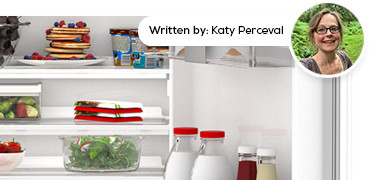
How to Clean and Organise Your Fridge
When was the last time your fridge had some TLC?
It’s a serious question – learn to love your fridge and it will love you. It might not give you flowers or bring you a tea in bed, but it will keep your food fresh and safe.
A clean well-organised fridge won’t just smell good (no ‘off’ salad bags at the back). It will also run more efficiently, cutting food waste and reducing your energy bills.
And when you’re rushing to feed the family after a long busy day at work, you’ll find what you need in a flash.
With Beko HarvestFresh Technology you can decrease food waste and keep your groceries fresher and crisper for an additional five days.
Sound good? Follow our simple guide to clean and maintain your fridge, so you can enjoy doing more of the things you love.
1. How often should I clean my fridge?
Family life is full on (we get that) but you should aim to deep-clean your fridge every three to six months. Do it when your fridge isn’t full, say the day before your big weekly shop. Wipe up any spills as you go along.
2. Emptying your fridge
Switch off your fridge, taking this chance to channel your inner ‘Marie Kondo’ and declutter as you clear it out.
Nobody likes wasting food, but any out-of-date items should be recycled, composted, or binned. Wipe down, dry jars and bottles, and store the food you plan to keep in a cool bag or box.
3. Cleaning your fridge shelves, racks and drawers
Carefully remove your fridge shelves, door racks, and fresh/crisper drawers. Many parts aren’t dishwasher safe so wash each by hand in warm soapy water. Let glass shelves reach room temperature first to avoid cracking.
Leave everything to air dry or dry with a clean cloth to avoid re-introducing germs.

4. Cleaning the inside of your fridge
Warm soapy water is good or a natural alternative such as diluted vinegar or bicarbonate of soda paste. Use a cotton bud or toothbrush for the grooves. Don’t forget the gulley and drain hole at the back where crumbs can fall.
Dry everything well with a clean cloth or paper towel.
5. Cleaning the outside of your fridge
Fridge handles and door edges get a lot of use. Sticky hands leave unseen germs so use a more powerful detergent here. Elsewhere, lukewarm soapy water will do.
Wipe door seals with a clean wet cloth and dry. These help keep warm air out and need to be kept free of grease and mould to do their job.
6. Don’t forget the coils
The outside back of the fridge isn’t somewhere most of us go. But if you can reach it safely, this is where you’ll find your fridge condenser coils. Tip: they will look like a black metal grid.
The coils help keep your fridge working efficiently for longer and (ideally) should be dusted or gently vacuumed at least once a year.
7. Restarting your fridge once it’s clean
Put the dry (room temperature) shelves, racks and drawers back in place and turn your fridge on. Allow it to cool to at least 5°C before restocking with food.
This may take a few hours, depending on your fridge’s make, model and age. If it doesn’t return to the right temperature there may be a problem and/or it may be time to buy a new fridge.
8. How to organise your fridge
So, your fridge is sparkling clean and cool. What’s next? The fun part…
Because as well as enjoying that ‘fresh fridge’ feeling, this is your chance to organise your fridge so you can easily find the food you want. Remember that a well-organised fridge won’t just look good. It will also work better as the air inside will be able to move.
Here’s how to organise your fridge to keep your food fresh and safe.
Top shelves: Cooked and ready-to-eat foods, including leftovers. Cooked food should always be stored higher than raw food to avoid contamination. Never put hot food in the fridge.
Lower/middle shelves: Dairy foods. Keep any milk at the back where it’s cooler, even if it’s on its side.
Bottom shelf: Wrapped raw meat and fish, as this is coldest part of your fridge.
Drawers: Vegetables, salads, fruit and fresh herbs in their original packaging. This will keep them fresh and crisp plus they won’t get stuck to the back.
Door shelves: Foods with natural preservatives, such as sauces, jams and juice, as this is the warmest part of your fridge and most prone to temperature changes.

Why don’t you give it a go?
Check out our range of refrigeration and organise your fridge today.
<< Previous
How to Clean Your Shoes


